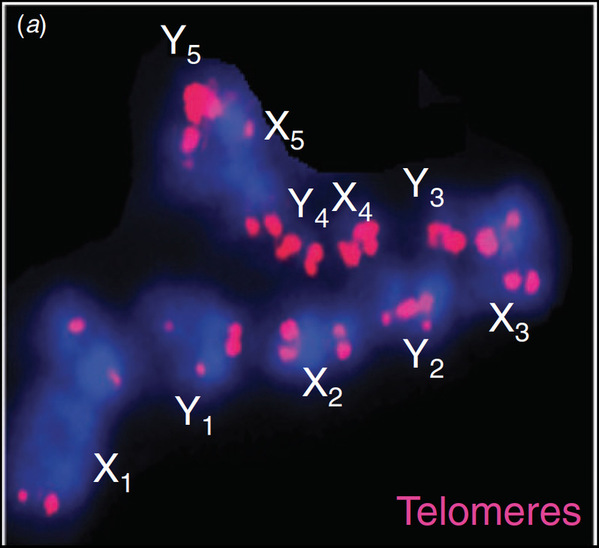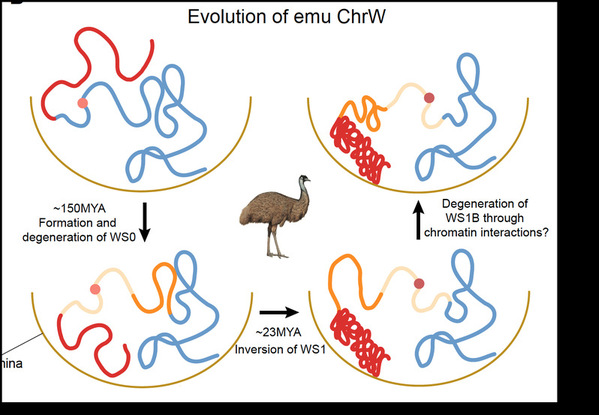Sex chromosomes genetically determine the remarkable differences between sexes from reproductive organs to the appearances and behaviors of adult individuals, and exhibit many genomic features and evolutionary patterns that are distinct from autosomes. They have long been the central subject of research for biologists.
Classical theories of sex chromosome evolution suggest that sex chromosomes often originate from a pair of ancient autosomes and that homologous recombination between sex-determining loci seldom occurs so that their exchanges between sex chromosomes are prevented. The cost of this recombination suppression is the irreversible degeneration of the male-specific Y chromosome or the female-specific W chromosome, with the loss of the vast majority of genes unrelated to sexes, thus becoming a "genetic graveyard." This general pattern of sex chromosome evolution, which has been reported in model organisms as humans and Drosophila, is currently being challenged by the results of other animal studies.
The research team led by ZHOU Qi from the Zhejiang University Life Sciences Institute published 3 different papers regarding the genome configuration and sex chromosome evolution about the platypus, the Australian emu, and the Peking duck in Nature, Genome Research and GigaScience. The work about platypus, published in Nature, was an international collaboration with colleagues from the University of Adelaide and the University of Copenhagen, and the other two projects were independently completed by ZHOU Qi's research team.
These three studies systematically delineate the dazzling diversity of animal sex chromosomes and provide new insights into the origin and evolution of sex chromosomes at three-dimensional genomic levels using Hi-C technology. In general, animals and plants only have one pair of chromosomes. However, the platypus, exclusively indigenous to Australia, not only has a unique appearance which combines the features of birds, mammals and reptiles, but also has five pairs of sex chromosomes which form a chain structure during meiosis. The genomic architecture and origin of this idiosyncratic sex chromosome system has been obscure. Research teams led by ZHANG Guojie from the University of Copenhagen, Frank Grutzner from the University of Adelaide, and ZHOU Qi worked cooperatively to combine PacBio long-read, 10× linked-read, chromatin conformation (Hi-C) and physical map data so as to produce a highly accurate chromosome-scale assembly of the platypus genome. Their research provided evidence that the monotreme sex chromosome complex originated from an ancestral chromosome ring. The formation of such a unique chromosome complex may have been facilitated by the unusually extensive interactions between the multi-X and multi-Y chromosomes that are shared by the autosomal homologues in humans. Comparative genomic analyses unraveled marked differences between monotremes and therians in haptoglobin genes, lactation genes and chemosensory receptor genes for smell and taste that underlie the ecological adaptation of monotremes.


Sex chromosomes of the platypus
The two other studies about avian sex chromosomes also exhibit a completely distinct pattern of sex chromosome evolution from that of mammals. The sex chromosomes of the Australian emu and the Peking duck, two widely domesticated poultry species, represent the early and middle stages of avian sex chromosome evolution, respectively, whereas the sex chromosomes of species such as humans, chicken, and Drosophila represent the terminal stage of evolution, when the sequences of the X and Y chromosomes or, in birds, the Z and W chromosomes are fully differentiated. The newly assembled genome sequence of the emu revealed that its sex chromosomes differ little from their ancient autosomal ancestors, with more than two-thirds of the regions still maintaining homologous recombination and high sequence similarity, and that a large number of transcriptionally active genes remain even in regions where recombination has been suppressed. Nevertheless, sex chromosomes of emu showed changes in chromosomal 3D configuration and interactions within chromosomal regions, suggesting that the evolution of sex chromosomes, with changes in overall configuration including topologically associated domains, may underlie changes in genome sequences and gene expressions. These findings provide new insights into molecular evidence of sex chromosome degeneration.


"These three studies reveal the complexity of sex chromosome evolution in animals, far beyond what biologists have known based on the model organisms," said ZHOU Qi. "New genomic technologies will render it possible to explore the sex chromosomes of non-model species, thus bringing new insights into the theoretical paradigm of sex chromosome evolution. And the high-quality genomes of poultry such as the emu or the Peking duck will be a vital reference for other researchers to develop economic traits of these species."






